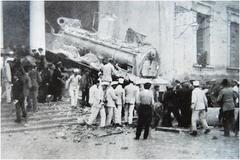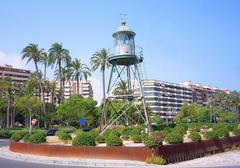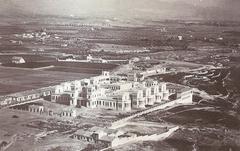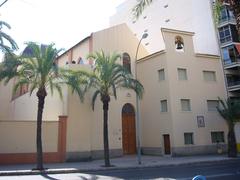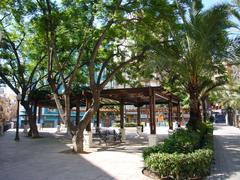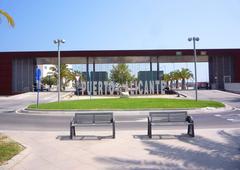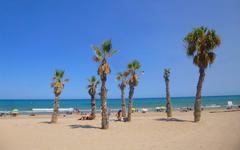
MARQ-Castillo Alicante Visiting Hours, Tickets, and Historical Sites Guide
Date: 04/07/2025
Introduction: Alicante’s Historical and Cultural Heritage
Alicante, a vibrant city on Spain’s southeast Mediterranean coast, is home to two of the region’s most significant cultural sites: the Museo Arqueológico Provincial de Alicante (MARQ) and the majestic Castillo de Santa Bárbara. These landmarks not only chronicle the city’s transformation from prehistoric settlements to a modern Mediterranean hub, but they also serve as leading destinations for visitors interested in archaeology, history, and immersive cultural experiences (MARQ official; alicanteturismo.com).
MARQ is recognized for its innovative blend of traditional displays and interactive technology, guiding visitors through millennia of local history—from early human communities to Roman, Islamic, and Christian periods. Overlooking the city, Castillo de Santa Bárbara stands as a testament to Alicante’s strategic importance, with its layered architecture, panoramic vistas, and dynamic cultural programming (Castillo de Santa Bárbara Official; maralicante.com). This comprehensive guide will help you plan your visit, providing practical details, historical context, and tips to make the most of your exploration.
Table of Contents
- Introduction
- MARQ Museum Alicante
- Castillo de Santa Bárbara
- Enhancing Your Visit
- Conclusion and Recommendations
- References
MARQ Museum Alicante
Visitor Information
Opening Hours
- Tuesday to Saturday: 10:00 AM – 7:30 PM
- Sunday and Public Holidays: 10:00 AM – 3:00 PM
- Closed Mondays (except public holidays)
Ticket Prices
- General Admission: €3
- Reduced Admission (students, seniors): €1.50
- Free Entry: Children under 16, Alicante residents, and on Sundays
Guided Tours and Accessibility
- Guided tours are available in multiple languages; advance booking is recommended.
- The museum is fully accessible and equipped for visitors with reduced mobility.
Location and Getting There
MARQ is centrally located at Plaza Dr. Gómez Ulla, 3, Alicante. It is easily accessible by public transport, taxi, or on foot from the city center.
Historical Highlights
Origins and Early Settlement
The region has been inhabited for around 100,000 years. MARQ’s Prehistory section displays tools and artifacts from early hunter-gatherers and Neolithic communities (MARQ official).
The Iberian Era
From the 6th to 1st centuries BCE, the Contestani tribe prospered here. The collection includes ceramics, sculptures like the Lady of Guardamar, and inscriptions illustrating trade and religion (Comunitat Valenciana).
Roman Conquest and Lucentum
Alicante’s Roman legacy emerges in artifacts from Lucentum, the ancient city that replaced Akra Leuke. MARQ features mosaics and a replica Roman merchant ship, providing insight into ancient commerce (Alicante About).
The Middle Ages: Islamic and Christian Alicante
Under Islamic rule, Alicante became Laqant, later reconquered by Christian forces. The museum and the castle together reflect the city’s medieval transformation (Spain.info).
Modern and Contemporary Developments
Artifacts from the 16th to 20th centuries document Alicante’s growth as a port and modern city. The museum itself occupies a former 1931 hospital, symbolizing this evolution (Alicante About).
Special Events and Exhibitions
MARQ frequently hosts major temporary exhibitions—such as the Chinese Terracotta Warriors—alongside educational workshops, summer camps, and guided tours. Check the official website for the current schedule.
Nearby Attractions
- Castillo de Santa Bárbara: The iconic fortress above the city.
- Lucentum Archaeological Site: Remains of the Roman city, managed by MARQ.
- La Illeta dels Banyets: Coastal archaeological site with Iberian and Roman layers.
Travel Tips
- Purchase tickets online to avoid queues.
- Combine your visit with a stroll through Old Town and the Explanada de España.
- Wear comfortable shoes for archaeological sites and the climb to the castle.
FAQs (MARQ)
Q: What are the visiting hours?
A: Tuesday to Saturday 10:00–19:30, Sundays and holidays 10:00–15:00, closed Mondays.
Q: How much are tickets?
A: General €3, reduced €1.50, free for children under 16 and residents.
Q: Is the museum accessible?
A: Yes, with elevators, ramps, and adapted facilities.
Q: Are guided tours available?
A: Yes, in several languages; book in advance.
Q: What other sites should I visit nearby?
A: Santa Bárbara Castle, Lucentum, and the Old Town.
Castillo de Santa Bárbara
Historical Background
Castillo de Santa Bárbara, atop Mount Benacantil, dates to the 9th-century Islamic period and has since seen expansions under Christian rulers. It has served as a fortress, prison, and now a cultural monument (Castillo de Santa Bárbara Official; Wikipedia).
Architectural Features
The castle is divided into three enclosures:
- Upper Enclosure (La Torreta): The oldest section, with the keep and the best panoramic views.
- Midsection: Features the Salon Felipe II, guardhouse, and Renaissance cistern.
- Lower Enclosure (Revellín del Bon Repós): Main entrance, dungeons, and former hospital.
Other highlights: the Weapons Courtyard, watchtower, and ancient lookout points (Spain Guides).
Visitor Experience
- Panoramic Views: Enjoy 360º vistas of Alicante and the Mediterranean—ideal for photography.
- Exhibitions: Learn about military history, architecture, and Alicante’s role in regional conflicts.
- Cultural Events: Concerts, dramatized tours, and family-friendly workshops are regularly hosted (Our Spanish Adventures).
Practical Information
Visiting Hours
- 15 Nov – 27 Feb: 10:00–18:00
- 28 Feb – 16 Jun: 10:00–20:00
- 17 Jun – 4 Sep: 10:00–23:00
- 5 Sep – 14 Nov: 10:00–20:00
(Closed 24 June, 24, 25, 31 December, 1 & 6 January. Last entry 30 minutes before closing.)
Tickets
- Entry: Free (special exhibitions and guided tours may have a fee).
- Elevator: €2.70 one way (free for pensioners).
- Shuttle Bus: €1.45 each way.
Getting There
- Elevator: From Postiguet Beach.
- Shuttle Bus: Runs from city center.
- On Foot: Several scenic but steep paths.
- By Car: Park in the old town; no parking at the castle.
Accessibility
- Most areas are accessible via elevator and ramps; some historic sections have uneven terrain.
Facilities
- Restrooms, café, shaded seating, souvenir shops.
Tips for Your Visit
- Plan for at least 2 hours at the castle.
- Arrive early or late to avoid crowds and capture the best photos.
- Wear comfortable shoes and bring water.
- Check for event schedules online (Castillo de Santa Bárbara Official).
FAQs (Castillo)
Q: What are the opening hours?
A: Vary seasonally; check above or the official website.
Q: Is there an entry fee?
A: Entry is free, but elevator and bus rides are charged.
Q: How accessible is the castle?
A: Elevator and ramps provide access to main areas; some historic areas are less accessible.
Q: Are guided tours offered?
A: Yes, both official and free tip-based tours are available; book dramatized tours in advance.
Q: Is it family-friendly?
A: Yes, with interactive exhibits and tours for children.
Enhancing Your Visit
- Download the Audiala app for up-to-date information, guided tours, and special events (Audiala).
- Explore virtual tours and photo galleries on official museum and castle websites.
- Follow MARQ and Castillo de Santa Bárbara’s social media for updates and events.
- Combine visits to MARQ, the castle, and nearby sites for a complete Alicante experience.
Conclusion and Recommendations
Visiting MARQ and Castillo de Santa Bárbara offers an immersive journey through Alicante’s rich history, from ancient settlements to modern times. MARQ’s innovative exhibitions, accessibility, and educational outreach make it a standout museum, while the castle’s dramatic setting and cultural programming provide a living connection to the city’s past (MARQ official; alicanteturismo.com; Castillo de Santa Bárbara Official; maralicante.com).
Plan ahead by checking opening hours, booking tours, and purchasing tickets online. Take advantage of digital resources and combine your visit with other local attractions for a truly enriching cultural adventure in Alicante.
References
- Visiting MARQ Museum Alicante: Hours, Tickets, and Historical Highlights, 2024, MARQ official (https://www.marqalicante.com/en/el-museo/)
- Visiting MARQ and Castillo de Santa Bárbara: Alicante’s Top Historical Attractions, Tickets, and Tips, 2024 (https://maralicante.com/travel-guide/alicantes-heritage-museums-and-historic-places/)
- MARQ Alicante Visiting Hours, Tickets & Guide to Alicante’s Premier Archaeological Museum, 2024 (https://alicanteturismo.com/en/museos/provincial-archaeological-museum-of-alicante/)
- Visiting Castillo de Santa Bárbara in Alicante: Hours, Tickets, Tours & Travel Tips, 2024 (https://castillodesantabarbara.com/en/castle-information/)
- Our Spanish Adventures, Visiting Santa Barbara Castle Alicante, 2024 (https://ourspanishadventures.com/visiting-santa-barbara-castle-alicante-everything-you-need-to-know/)
- Audiala, Archaeological Museum of Alicante, 2024 (https://audiala.com/en/spain/alicante/archaeological-museum-of-alicante)

